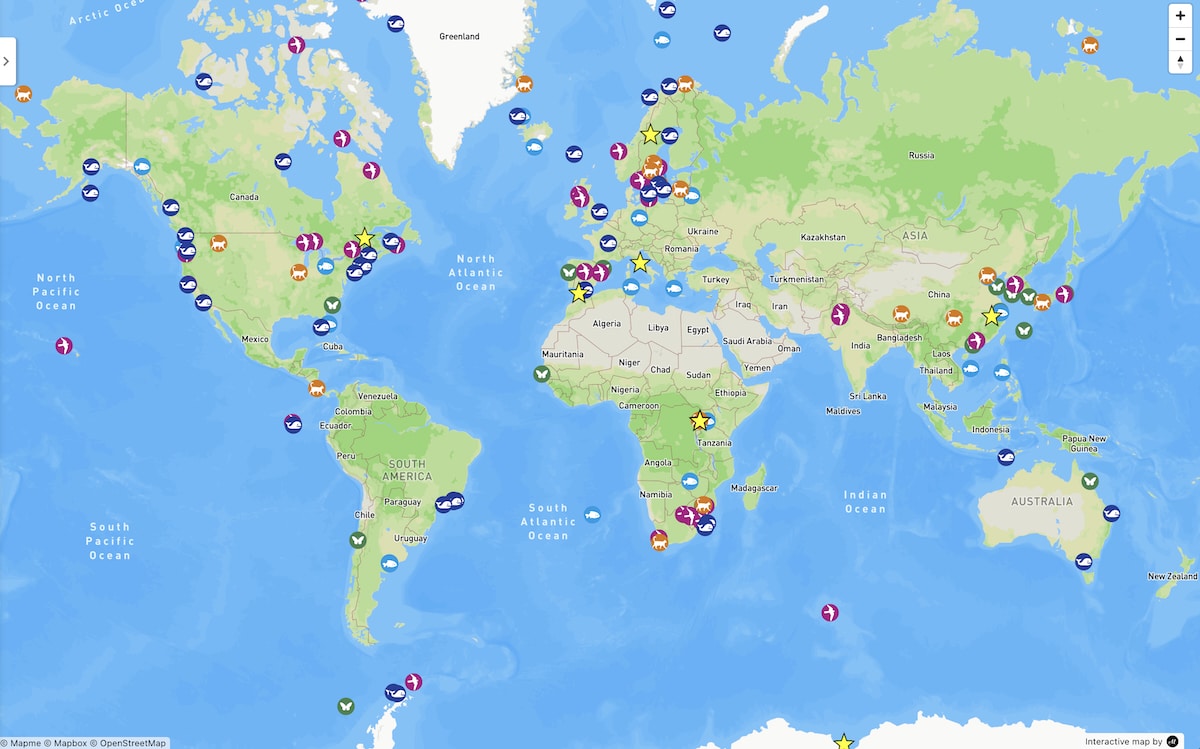Global Wildlife Harmed by Flame-Retardant Chemicals, New Map Shows

 Why you can trust us
Why you can trust us
Founded in 2005 as an Ohio-based environmental newspaper, EcoWatch is a digital platform dedicated to publishing quality, science-based content on environmental issues, causes, and solutions.
Often when we talk about the health implications of particular chemicals, the conversation tends to focus on the human impact, yet animals also suffer when harmful chemicals accumulate in their bodies and ecosystems.
A new map highlights how pervasive the problem is for wildlife around the world by showcasing the scientific evidence linking so-called flame-retardant chemicals and poor health factors in dozens of different species. From fish to insects to large mammals, over 100 species from every continent are identified on the map, published by the Green Science Policy Institute, a nonprofit focused on the health impact of chemicals.
Flame retardant chemicals, such as polychlorinated biphenyls, or PCBs, are found in an array of common household products and materials, like furniture, carpets, electronics and construction supplies. Many of the products they’re found in are legally required to have them in order to purportedly reduce flammability and slow the spread of fires.
The substances can end up in our air, water or soil by burning or taking apart items that contain them or even just through their manufacturing process and normal use.
The repercussions for anyone living among such substances are insidious. The National Institute of Environmental Health Sciences (NIEHS) notes that flame retardant chemicals can lead to “endocrine and thyroid disruption, immunotoxicity, reproductive toxicity, cancer and adverse effects on fetal and child development and neurobehavioral function.” Plus, these chemicals don’t break down easily, so flushing them out of an environment or an individual animal or person is out of the question.
Take the beluga whale, for example, an endangered species of whale found in the Arctic Ocean and adjacent seas. In southeast Canada’s St. Lawrence estuary, many members of the endangered whale’s population “have suffered from cancer, likely due to pollutants including polycyclic aromatic hydrocarbons and flame retardants,” according to GCPI’s map.
Across the world, the map highlights China’s Yangtze River Delta, where snakes and frogs, like the black spotted frog, living near e-waste recycling facilities were found to “have high levels of many flame retardants in their bodies, which can be transferred to their eggs.” That makes the bioaccumulation not only a health problem for the individual creature but for future generations, too.
But for Lydia Jahl, the project lead and the nonprofit’s science and policy manager, one of the most unexpected highlights of the map is the study showing high levels of flame retardants in endangered chimpanzees living in an Ugandan national park.
“You wouldn’t think that animals similar to humans, especially, would have such flame retardant exposure in a national park,” notes Jahl. “That really stood out to me.”
While the NIEHS notes on their website that the use of flame-retardant chemicals “can offer benefits when added to certain products,” the Green Science Policy Institute says the benefits aren’t plentiful.
“It’s definitely possible that certain uses… might help prevent fires, like with faulty electronics,” says Jahl, who notes, “We’re not saying that there’s never any benefit but rather that many benefits… have been overblown and because there’s an associated health harm due to the use of these chemicals, we want to be really critical of where flame retardants are used.”
GSPI’s map — primarily compiled by GCPI intern Maddie Dolan — doesn’t highlight every species that has been studied for flame retardant chemical health impacts — only a fraction of the published, peer-reviewed studies out there were included — but not many species have been studied, the organization notes.
Part of that is because the natural biodiversity of our planet makes it hard to access and study more creatures, Jahl explains. But there’s also the matter of funding.
“There’s just simply not enough funding in environmental science in general for scientists to be able to do that breadth of work, it’s difficult work and it’s expensive work,” she says. “We also see that it’s mainly researchers from advantaged institutions that have the financial capability to conduct this research, so there’s areas of the world where there’s definitely more blank spots on the map.”
“There’s definitely an equity issue,” she adds.
Subscribe to get exclusive updates in our daily newsletter!
By signing up, you agree to the Terms of Use and Privacy Policy & to receive electronic communications from EcoWatch Media Group, which may include marketing promotions, advertisements and sponsored content.

 233k
233k  41k
41k  Subscribe
Subscribe 




